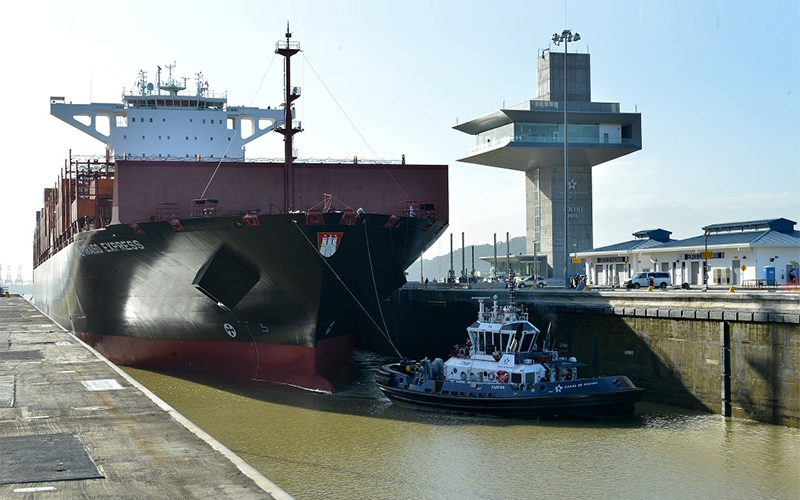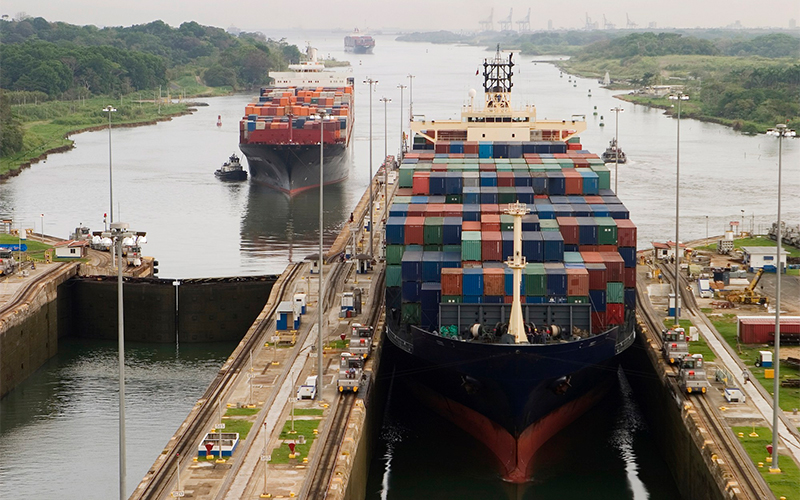
OVERVIEW
MANAGEMENT
PERFORMANCE
POSSIBILITIES
CAPITALS
ACTIVITIES
ACTORS
BURGESS
Transportation / Shippng |
|
Burgess COMMENTARY |
|
TRANSPORTATION Panama Canal Welcomes the Largest Capacity Vessel To-Date Through its Expanded Locks
Tuesday's passage of Hapag-Lloyd's Valparaiso Express ushered in a new era of mega-ships that are now able to transit the Expanded Panama Canal since it's inauguration on June 26 of this year. The new locks, which are 70 feet wider and 18 feet deeper than those in the original Canal, are able to accommodate Neopanamax vessels carrying up to 13,000 to 14,000 TEUS. The vessel began its transit at the Pacific-facing Cocoli Locks Tuesday morning, following calls at ports in Chile, Peru, Ecuador and Colombia. After completing its transit through the Atlantic-facing Agua Clara Locks, the ship will stop at Manzanillo International Terminal in Panama and will continue its route to terminals in the Dominican Republic, United Kingdom, Germany, Belgium, France and the Netherlands. The Valparaíso Express is part of Hapag-Lloyd's Europe - South America West Coast service, which covers a nine-week rotation, merging two previous services between Northern Europe and the West Coast of South America. The containership measures 333 meters in length and 48 meters in width, and is the first of five new vessels in Hapag Lloyd's new 10,500 TEU class which are specifically being built to take advantage of the additional capacity the Expanded Canal affords. When the final four ships are completed in April 2017, all five will be able to transit the Expanded Canal. Environmental Sustainability Contributions Recognized In addition to its consideration of the Expanded Canal's new dimensions, the Valparaiso Express was built with the highest environmental standards in mind. The vessel was constructed with an environmentally friendly landside shore connection, which allows the auxiliary diesels on board to be switched off while in port. In addition, the vessel features a fuel-efficient 46,530-horsepower main engine with an emissions-reducing valve control, and ballast water treatment units on board in accordance with the new International Ballast Water Management Convention, which purify the ship's ballast water without the use of harmful chemicals. Moreover, the technical specifications of this new ship will help reduce large quantities of sulfur oxide (SOx) and nitrogen oxide (NOx) emissions. By using the Panama Canal, the Valparaiso Express reduces more than 8,500 tons of carbon dioxide (CO2) emissions on its roundtrip voyage compared to other conventional routes that the vessel would have to use without the Expanded Locks, making the Panama Canal the most environmentally friendly route. In recognition of its substantial emissions reductions, the Panama Canal awarded the vessel with its newly established Green Connection Award, an initiative created to recognize Canal customers who demonstrate excellent environmental stewardship, and to encourage others to implement technologies and meet standards that help reduce greenhouse gas emissions.
Related: The New Expanded Panama Canal: Bigger Ships, Bigger Paydays for Beans, Coal, and Gas Download the Paper: How the Panama Canal Expansion Is Redrawing the Logistics Map How the Panama Canal Expansion Is Redrawing the Logistics Map View & Download Related Companies Boston Consulting Group C.H. Robinson Following the Panama Canal expansion, up to 10 percent of container traffic to the U.S. from East Asia could shift to East Coast ports by 2020, however, West Coast ports will still handle more traffic than they do today, but their market share will likely fall. By C.H. Robinson & The Boston Consulting Group 225 inShare September 08, 2016 The expansion of the Panama Canal will be the headline event in shipping in 2016. The $5 billion project promises to reorient the landscape of the logistics industry and alter the decision-making calculus of the shippers that the canal serves. According to research conducted jointly by The Boston Consulting Group and C.H. Robinson, as much as 10 percent of container traffic between East Asia and the U.S. could shift from West Coast ports to East Coast ports by the year 2020. Small percentages translate into big numbers in container traffic on highvolume lanes between East Asia and the U.S. This trade represents more than 40 percent of containers flowing into the U.S. Rerouting 10 percent of that volume, therefore, is equivalent to building a new port roughly double the size of the ports in Savannah and Charleston. This shift will have profound effects. The larger ports on the West Coast will experience lower growth rates, altering the competitive balance between West Coast ports and East Coast ports. (With global container flows rising, West Coast ports will still handle more containers than they do today.). It will also shape the investment and routing decisions of rail and truck carriers, magnify the trade-offs that shippers make between the cost and the speed of transportation, and potentially alter the location of distribution centers. West Coast ports currently receive two-thirds of container flows from East Asia, with much of that cargo moving by rail and truck as far east as the Ohio River Valley, about three-quarters of the way across the U.S. But once the big, efficient “post-Panamax”container ships begin passing through the wider, deeper canal, the shipping dynamics will change. For shipping to many destinations, using West Coast ports will still be the fastest option - but it won’t necessarily be the cheapest. For price-sensitive cargo that is relatively expensive to move, routing shipments through East Coast ports to inland destinations will become more cost competitive and increasingly attractive. In this report, we explain how shippers, carriers, and infrastructure operators (such as ports) need to respond to this shifting logistics environment, including: The Changing Logistical Landscape Growth rates for the larger ports on the West Coast will decrease, competition among East Coast ports will intensify, and rail and truck traffic patterns will shift. The Time Versus Cost Trade-Off The West Coast will always be the fastest option for reaching much of the U.S., but the East Coast will become the least costly option for many shippers. The Battleground The battleground on which U.S. ports compete for customers will move several hundred miles west, to a region that accounts for more than 15 percent of GDP. Urgency to Act The expansion underscores the need for shippers and carriers to adapt their strategies and operations in light of the growing complexity of the logistics field. Our review, we believe, is the most analytical public study of how the expansion of the Panama Canal will alter the logistics landscape of the U.S. Log in to download this paper. Related Companies Boston Consulting Group Company Quicklook Related Download How the Panama Canal Expansion Is Redrawing the Logistics Map Following the Panama Canal expansion, up to 10 percent of container traffic to the U.S. from East Asia could shift to East Coast ports by 2020, however, West Coast ports will still… |
|
December 22, 2016 |
| The text being discussed is available at http://www.supplychain247.com/article/panama_canal_welcomes_largest_capacity_vessel_to_date_through_its_locks and |

